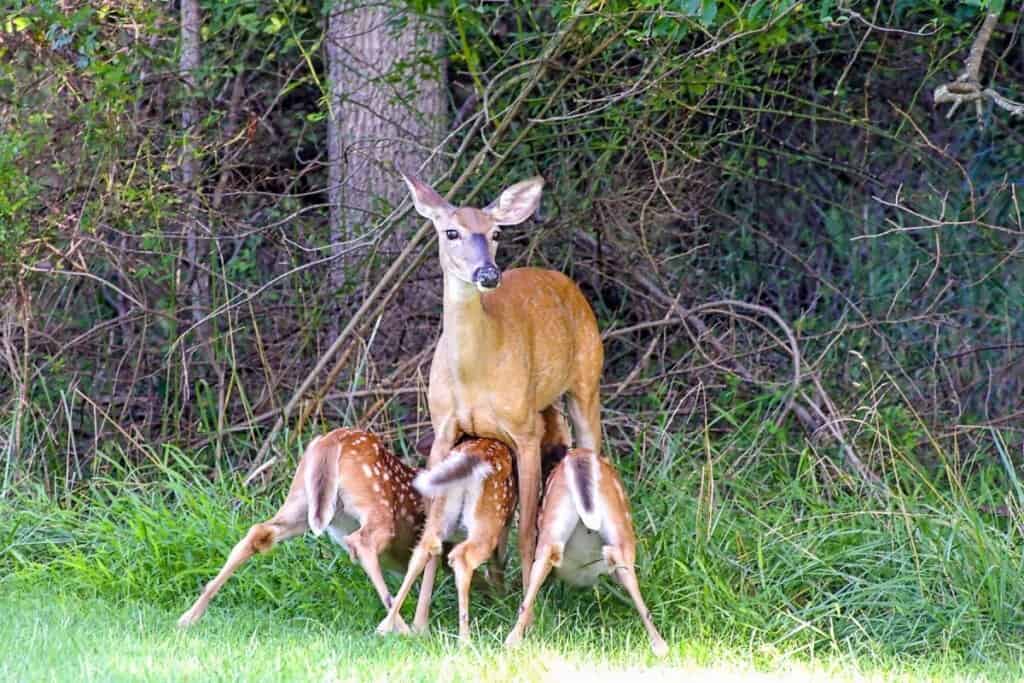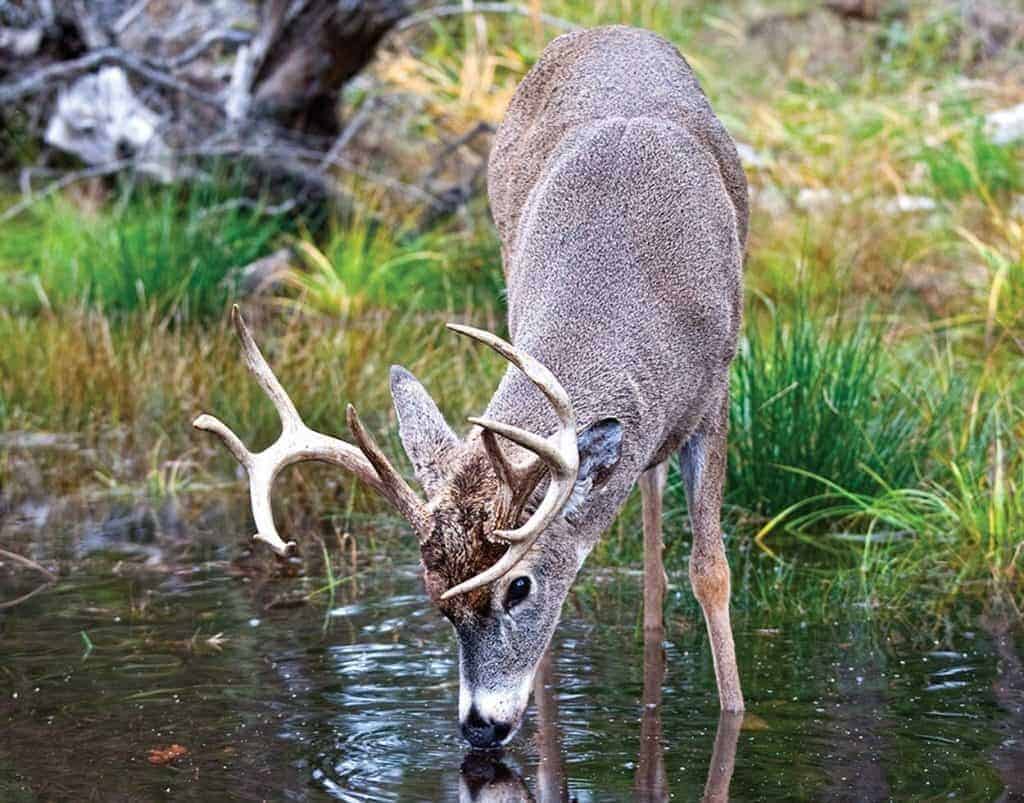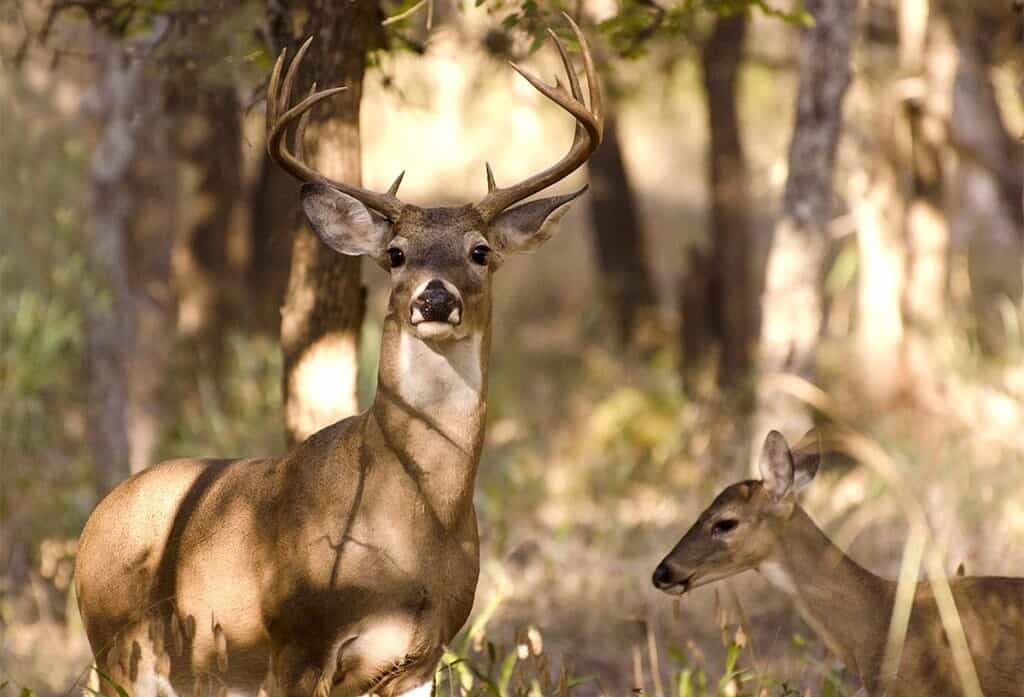For any hunter that wants to better manage their property, buck to doe ratio is definitely something you have heard of before. There is plenty of debate on what the best buck to doe ratio is, but the most sought-after buck to doe ratio is 1 to 1. Although that ratio sounds good, it may not be obtainable. On the other hand, a ratio that is heavily skewed towards does is also not healthy for the whitetail population. So here we will figure out what an ideal buck to doe ratio is, and why it matters. Then we will learn how to estimate your buck to doe ratio so you know exactly what you need to do to make your deer herd as prosperous as possible.
What Is the Ideal Buck to Doe Ratio?
Your initial thoughts about buck to doe ratio may make you want a clean 1 to 1 ratio. Although that is the ideal ratio, we are not able to really confirm our buck to doe ratio. So if you are too aggressive about going for a 1 to 1 ratio, you might wind up harvesting too many does, and having more bucks than does on the property. That sounds cool at first, but it would be more difficult for the population to sustain itself.
An unmanaged hunting property will have a buck to doe ratio of around 1:3 to 1:5, and 1:3 is actually not all that bad. What we want to shoot for is 2 does to every buck, or slightly less than two does per buck. At this ratio, the population is fairly even and it is also healthy. This way we can have a whitetail population that is producing plenty of fawns and it also has quite a few bucks for us to nurture into mature trophies.
Why Buck to Doe Ratio Matters
Does an imbalanced sex ratio really have any negative effects? Is it something that you really need to worry about? Well, if you are not seriously hunting a property and taking multiple deer off it every year, you probably do not have to worry about it. Nature has a beautiful way of balancing everything out, including sex ratios. If a property is severely out of balance, say one buck for every 8 or 10 does, it will start to even itself out to our average we stated before of about 1:3 to 1:5. We will talk more about this later, but if you are trying to manage your property so that it is the best that it can be, buck to doe ratio is an important factor that needs to be kept in check.
Scrap the Rut and Fawn Production
There are a few things that can happen as a result of an imbalanced sex ratio. For starters, if there are a ton of does and not so many bucks, there is going to be much less competition during the rut. The average whitetail buck can breed 7 to 8 does during a season before he is exhausted, and he is not going to do that all at one time either. This is going to make the rut much less eventful in your area. Plus all the rattling and aggressive rut tactics that we usually use to get mature bucks to come our way are not going to work very well.
So what we see happen on properties with many more does than bucks is does coming into estrus and not being bred. If that happens, they may come back into estrus later in the rut when bucks have recovered and may or may not be bred. Then come spring when fawns start hitting the ground, births are spread farther out. Instead of the majority of fawns being born at the same time, we get smaller groups born about a few weeks apart. This leads to increased predation from coyotes and bobcats. Which gives us an even smaller amount of fawns making it to adulthood than normal.

Provide More for Bucks and Essential Does
Next, when there are many more does than bucks on the property, there will be less food for the bucks. The property will still carry its maximum carrying capacity, but if we take a page out of Thanos’s book, we can eliminate the extra does we have. This will provide more food to our bucks and the essential does. This gives your does a better chance of successfully raising fawns, and gives our bucks more nutrients to grow to maturity, and makes sure all deer in the area have enough food to stay healthy. If you combine this with a food plot, the essential does will be healthier and be more successful with their fawns and your bucks will have the resources they need to grow antlers to the best of their genetic ability.
Improving the Average Maturity Level of Bucks
With more bucks overall, the mature bucks on your property are no longer going to be 2 ½ years old. With more bucks and better management, ideally, younger bucks are not going to be harvested every year. That being said, if evening out the ratio or even attracting more deer to your property is something you are just starting to try out, that may mean that you need to refrain from harvesting too many bucks off the property for a few years. Harvesting 1-2 bucks during the rut is fine, but if you let others hunt your property and normally harvest 5, 6, 7, or more bucks, you may want to slow it down a bit so those bucks can mature while the ratio is evened out. Let those hunters harvest does instead.
As the years go on and you have a larger buck population, there will be a core population of mature bucks that will replace themselves year after year. If your does are healthy and you are adding more fawns each year, you will have a population of button bucks. Last year’s buttons are now 1 ½ year’s old, and so on. Each generation of bucks are going to gain a year of maturity each year. If you do not harvest them for a few years the overall maturity level of deer on the property will also grow. Eventually, you will have bucks coming into their prime maturity level every year and with a larger property, you can afford to harvest plenty of these bucks without harming your ratio.
This also has a lot to do with how much land you are working with. If you are hunting on 20-300ish acres, most of the deer in the area are going to be moving back and forth between your property and others. So if you are hunting a small property and your neighbors are shooting every buck they see, there may not be much you can do about the average maturity level of bucks in the area.

How to Estimate Your Buck to Doe Ratio
The main approach to estimating your buck to doe ratio is through a trail camera survey. This is where you put out some sort of bait and put up a camera close by. You want to make a few of these sites around your property. I would say the max should be 1 site per 100 acres. The best time of year to try out this survey is in August. This is when bucks are falling into their early-season behavior patterns, and they have also shed their velvet so you can identify them easier.
You want to make sure that you are keeping records of how many deer you are seeing at each site. Try to use the highest quality camera you can, because you want to be able to identify these deer so you are not counting the same deer multiple times. This may be near impossible with does, but we can definitely keep up with bucks.
You want to carry out the survey for about 2-3 weeks. I recommend you check your cameras weekly, but knowing that they will be there a while make sure you have fresh batteries in them. You do not want to lose a week’s worth of data because of a bad battery. Make sure you also set a delay on your camera so that you can save some space on your memory card, I recommend 1-3 minutes depending on how big your card is.
This is a great time to get to know the bucks in your area, and even try to get some of their patterns figured out. While I do not suggest having too many bait sites, that does not mean you should not place any more cameras around the area. If you have cameras to spare, put them up in other natural hotspots. Keep taking inventory of your bucks throughout the preseason, even if they seem to be nocturnal, you can catch those bucks during the rut.
While this is a popular and somewhat passive way to estimate your buck to doe ratio, it is not the only way. Another simple way to survey the population is to get out there yourself and watch. Set up in a field or near a natural hotspot with your binos and record what you see. There are a handful of ways to estimate your buck to doe ratio, but the trail camera method is just about the easiest and most reliable. That being said, none of the methods are super reliable, we are getting an estimate only, and it is a rough estimate at that. That is why I mentioned earlier that you want to shoot for a 1:2 ratio, that way if you are a bit off, you will not kill too many does.
Buck to Doe Ratio Often Self Corrects

Like I mentioned before, nature has a beautiful way of evening things out, even when we mess with it quite a bit. Kip Adams of the QDMA (now the NDA) published a great article in 2013 about how nature takes care of the buck to doe ratio. To explain how this happens let’s use a theoretical whitetail population as Kip did in his article.
Assume we have a property about 500 acres large. A conservative number for the average acreage a deer takes up is 10 acres. So with a deer every 10 acres, that leaves us with 50 deer living on our 500-acre parcel. Let’s say our buck to doe ratio is super out of whack and is 1:9. That’s 5 bucks and 45 does.
- During the preseason we have 5 bucks and 45 does, a ratio of 1:9
- Say we hunt this parcel and take 4 of the 5 bucks during the rut and zero does. The ratio is now 1:45. You can expect each of these bucks to breed about 5-7 does if we let them go through the rut.
- There will also be some natural mortality that occurs so we can say that 5 does will be lost and our last standing buck also dies. Our ratio is 0:40
- Come spring our bucks will have sired around 20 fawns that survive to adulthood. 20 surviving fawns is a conservative estimate considering our bucks could have easily bred 25-35 does, which normally produce twins with ample resources. 10 of our 20 fawns are likely to be male. Assuming your property does not have a high fence, a few other deer are bound to wander onto the property, especially if it is small, so say we gain 5 bucks and does alike from other properties. We now have 45 does and 15 bucks. 10 of which are yearlings but can still breed does during the next rut. Now our buck to doe ratio is 15:45 or 1:3(which is just about as good as it gets on unmanaged land).
| Event | Bucks | Does | Buck:Doe Ratio |
| Preseason | 5 | 45 | 1:9 |
| Harvest | -4 | 0 | |
| Natural Mortality | -1 | -5 | |
| Postseason | 0 | 40 | 0:40 |
| Fawn Recruitment | 10 | 10 | |
| Other Deer Home Range Change | 5 | 5 | |
| Spring Population | 15 | 45 | 1:3 |
This is dramatically better than what we started with and we even have more deer than when we started. Although you can see this is how some areas of the United States only have yearling or two-year-old bucks. If young bucks are continuously harvested, you will keep getting more yearling bucks to replace them, leading to a property that will likely never produce a mature buck.
The natural ratio will hover around 1:3 up to about 1:5 before biology takes effect and evens things out. During the next year on our hypothetical parcel, it is very possible that the ratio falls back to 1:5 if we lose a few bucks and the fawn recruitment favors females. Although again the year after that number of bucks will raise, lowering the ratio again.
The moral of the story is that left unchecked, you are not going to run out of bucks, you may just run out of mature bucks. The fact is that nature does not care if the males reach peak maturity, they just have to be old enough to breed and the species as a whole can survive.
Although if we can alter the ratio through good deer management, we can get the ratio as close as possible to 1:1 which will give us many more bucks to try and grow into trophies. A property that consists of 15 bucks and 45 does consumes the same amount of resources as a property that consists of 30 bucks and 30 does. Obviously, we want the property with more bucks so we can have the best chance possible of harvesting a mature whitetail.
Conclusion
Buck to doe ratio is a powerful statistic that can tell you just how well your property is doing in terms of producing mature bucks. It is also important to keep it relatively low so that the population can be as healthy as possible. Although just having a 1:1 buck to doe ratio is not going to grow giants on your property. You still need to focus on other habitat management tasks, like providing good bedding or planting food plots

